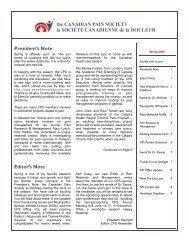Mehran Midia - The Canadian Pain Society
Mehran Midia - The Canadian Pain Society
Mehran Midia - The Canadian Pain Society
Create successful ePaper yourself
Turn your PDF publications into a flip-book with our unique Google optimized e-Paper software.
Anatomy of Imaging <strong>Pain</strong>ful Spine<br />
In order to utilize appropriate imaging tools in order to diagnose and treat patients with<br />
acute or chronic spinal pain it is essential to:<br />
A. Be familiar with spinal anatomy and pain generators in the spine<br />
B. Have a clear understanding of indication of imaging<br />
C. Order appropriate imaging tool depend on anatomy and etiology in question<br />
D. Understand the limitation of the individual test and interpretation<br />
E. Be systematic and methodical in approaching the clinical question and the<br />
evidence<br />
A- Cause of spinal pain can be divided based on:<br />
Location: Disc, nerve, facet, ligamentum flavum<br />
Etiology: Degenerative, infectious, inflammatory, neoplastic, iatrogenic, etc<br />
And further more could be:<br />
a. Discogenic Due to<br />
a. Expression of inflammatory degenerative disc by-products<br />
b. Direct annular innervations by nociceptive fibers<br />
b. Encroachment of the nerve roots<br />
a. Radiculopathy (disc, facet, lig, muscle)<br />
b. Lateral recess stenosis<br />
c. Neural foraminal stenosis<br />
d. Extra-foraminal (piriformis synd)<br />
e. Spinal canal narrowing (pseudoclaudication)<br />
c. <strong>Pain</strong> from the affected spinal element<br />
a. Facet arthropathy, spinous process<br />
d. Sacroiliac Joint<br />
e. Motion and instability
B- "<strong>The</strong> wise man doesn't give the right answers, he poses the right questions." Claude<br />
Levi-Strauss<br />
“You can tell whether a man is clever by his answers. You can tell whether a man is wise<br />
by his questions." Naguib Mahfouz<br />
In order to get the best out of imaging consultation it is prudent for the refereeing<br />
physician to have taken a full history and examined his or her patient thoroughly and to<br />
communicate their findings to the radiologist.<br />
Imaging yield increases if ordering physician is able to generate and communicate a<br />
specific question or concern rather than working on shut gun approach (GIGO). Also<br />
having more information is helpful for the radiologist to use proper protocol for imaging<br />
and make suggestion for additional imaging if needed.<br />
Question that often arise can be divided into:<br />
1- Confirmation of clinical judgment and establish cause<br />
2- Exclusion of sinister or treatable disease<br />
3- Guide treatment<br />
4- Assess for complications<br />
Social indication of imaging often results in imaging reports with little benefit in overall<br />
patient care and may cause delay in diagnosis if it is not appropriately used.<br />
1- Reassure patient<br />
2- Defensive medicine and medicolegal concerns<br />
3- Buy time<br />
C- Spine can be imaged using conventional x-ray, CT, MRI, Bone Scan, Myelogrpahy,<br />
Discography and Bone Densitometry. <strong>The</strong>se tests could be used stand-alone or in<br />
combination depend on the specific question that is needed to be answered, structure in<br />
question and potential etiology that is being entertained. Conventional x-ray and CT are<br />
useful to assess osseous structures. MRI is essential for assessment of soft tissues and is<br />
the workhorse of spinal imaging for variety of conditions. Intravenous contrast is helpful<br />
when assessing for post surgical scar, infection, tumor or arachnoiditis. CT myelography<br />
is only indicated in assessing patient with spinal hard ware in place when conventional<br />
CT or MR is inconclusive.<br />
D- <strong>The</strong> physician ordering the test should have an understanding of indication and<br />
contraindication of each test, limitations due to inherent techniques, sensitivity,<br />
specificity, accuracy positive and negative predictive value, intra and inter observer<br />
variability of the test they order.<br />
Not knowing these limitations and omitting to investigate the correct piece of anatomy<br />
with the correct investigation could result in sense of false security and significant delay<br />
in proper treatment of their patients. It also this could result in many incidental finding<br />
that could trigger a battery of unnecessary and related investigation.
Always do remember that spine is a window to the spinal cord and is a part of nervous<br />
system. It is wise to look up and down!<br />
E- Following a systematic checklist could be helpful for physicians when reviewing<br />
imaging of their patient presenting with spinal pain.<br />
Using ABCDEFs Spine imaging makes interpreting imaging easy.<br />
Alignment<br />
Bone Density, Bone Marrow<br />
Canal, Cord, Conus Medullaris, Cauda Equina<br />
Disc<br />
Epidural, Extraforaminal, Enhancement<br />
Foramina, Facet, Lig Flavum, Fracture<br />
IJ, Sacrum<br />
Patient with prior back surgery often seek medical attention with persistent or recurrent<br />
symptoms. <strong>The</strong> causes of failed back surgery are as follows:<br />
Early: Hematoma, infection, insufficient decompression, nerve root trauma,<br />
unrecognized disc fragment, Sx at wrong level<br />
Late: Arachnoiditis, Epidural fibrosis, Facet Degeneration, instability, new or<br />
recurrent disc herniation, pseudomenigocele, spinal stenosis, osteomyelitis<br />
In Conclusion:<br />
“<strong>The</strong> radiologist who takes a superficial history and allows it to influence his diagnosis is<br />
a menace. Certain x-ray appearance makes operation desirable, regardless of the<br />
diagnosis suggested by classical clinical medicine. On the other hand, the clinician cannot<br />
shift his/her responsibility to the radiologist. It is his/her duty to ask himself weather the<br />
symptoms can be explained based on the x-ray findings or weather an alternative<br />
explanation is essential. <strong>The</strong> x-ray department can be as good as the clinician it allows it<br />
to be, without the fullest collaboration mistakes and mutual recriminations are<br />
inevitable,”<br />
Book Summary from British Medical Journal page 914 Oct. 22 nd 1949. “Radiologist and<br />
Clinicians” By De M, Chiray et al. Paris 1949.<br />
D. A Jennings
















